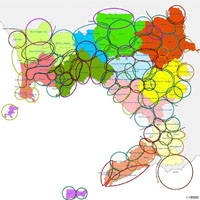Communication Network and settlements in the PTCP of Naples
Abstract
The Territorial Plan of the Province of Naples (PTCP) framework is given by European Planning and research (ESDP and ESPON). Regional strategic spatial planning suggested development directions while making important investment in the rail transportation network. The cohesion spatial policy was focused on the controversial concept of mega-metropolis contrasted by the concept of the development platform. From such discussion cooperation programs come with the great cities of the Southern Italy Rome and Bari, the strengthening of transportation infrastructure and the development of the nodes of interrelations. Inside the metropolitan area, the high concentration in the city of Naples and the high density of the shoreline are the starting point for a policy of inland development according to strengting of the east-west corridor connecting the Tyrrhenian to the Adriatic See and the overseas lands of the south-east Europe. The paper analyses the transportation system supporting this more northern part of the Province and found some areas, in the middle, lacking of enough commuting facilities, even in the Regional plans evaluating a rail service or a new tramway network alternative. The paper shows what meaning polycentricity has in the PTCP and highlight its strategic perspective: a set of centres at the some ranking for service furniture to families and firms in the poles of the transportation infrastructure. A pilot project has been the development of a CBD in the new location of High Speed train station 10 Km. north of the city core. Because the metropolitan area results from the joining of a net of old cities, town and villages, one task of the PTCP has been to asses their role in the functional complex and to plan what rank will reach in the future to have a more equilibrate whole. One of the rationale was to check the compatibility of the new functions with the urban morphology. This study demonstrated the need of new centralities. Governance in a setting where constitutional organization gives the main planning powers to municipalities hardly associate higher levels as the Provincial one, the younger in the planning system. In this case Naples PTCP focuses on the population territorial distribution acting on the municipal housing objectives. In conclusion, arguments are given to explore the sustainability of the polycentric concentrated ad mix use model. Confronted with the transportation system it seems the only one able to give a preference to the collective commuting mode, fighting the suburban sprawl and its dependency on car commuting.Downloads

Copyright (c) 2014 Tema. Journal of Land Use, Mobility and Environment

This work is licensed under a Creative Commons Attribution 4.0 International License.
Authors who publish in this journal agree to the following:
1. Authors retain the rights to their work and give in to the journal the right of first publication of the work simultaneously licensed under a Creative Commons License - Attribution that allows others to share the work indicating the authorship and the initial publication in this journal.
2. Authors can adhere to other agreements of non-exclusive license for the distribution of the published version of the work (ex. To deposit it in an institutional repository or to publish it in a monography), provided to indicate that the document was first published in this journal.
3. Authors can distribute their work online (ex. In institutional repositories or in their website) prior to and during the submission process, as it can lead to productive exchanges and it can increase the quotations of the published work (See The Effect of Open Access)
